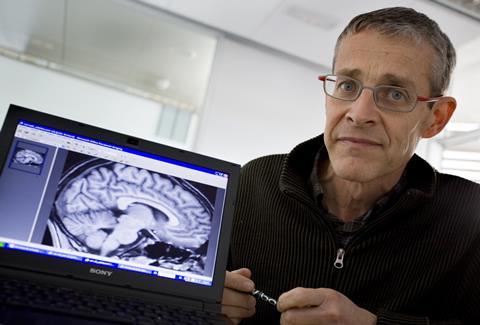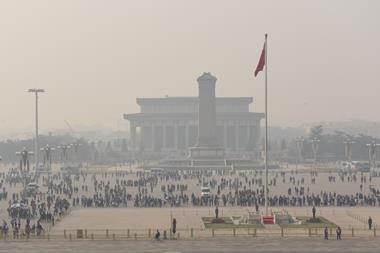Small particles in the air can find their way into the brains of growing children, with seriously unpleasant consequences. Anthony King reports
As children play, walk to school and sit in classrooms, their brain development is disrupted by the unseen menace of air pollution. This was illustrated for those living in urban areas in a landmark study in the Spanish city of Barcelona, which looked at 3000 schoolchildren in dozens of schools. Children in schools with more traffic pollutants had slower cognitive development.
The chief investigator was Jordi Sunyer at the Barcelona Institute for Global Health, who has studied air pollution for decades. He describes the findings from this project as the strongest in his career. ‘The results were shocking and convinced me that fine particles are a very serious problem,’ he says. This adds to an expanding stack of evidence showing that air pollution doesn’t only impact people’s hearts and lungs, but their brains too – especially in children.
The results were shocking and convinced me that fine particles are a very serious problem
The tiniest particles, below 2.5µm micrometres in diameter, are under most suspicion. Diesel exhaust is an especially significant source of these fine (less than or equal to 2.5µm, termed PM2.5) and ultrafine particles (less than 100nm, termed ultrafine). And the problem is more widespread than you may think: over 80% of the world’s population lives in urban areas with levels of air pollution higher than World Health Organisation guidelines. London is one of the worst affected, currently ranking 2516th out of 3226 global cities with more than 100,000 inhabitants for air pollution.
Alzheimer’s link
The Barcelona investigation, reported in 2015, was inspired by enquiries first made in Mexico City by Lillian Calderón-Garcidueñas, now at the University of Montana in the US. In the early 1990s, she was intrigued by new arrivals to her native city suffering from nose bleeds. Her findings implicated pollution. Subsequently she compared the brains of aged dogs from heavily polluted areas to those from cleaner cities. Autopsies revealed inflammation and protein clumps that are the hallmarks of Alzheimer’s disease in pet dogs from heavily polluted streets.
In follow-up studies, she found structural and metabolic changes in children’s brains from autopsy tissue and magnetic resonance imaging (MRI) studies. She documented Alzheimer-like pathologies in 11-month-old babies, including the accumulation of amyloid plaques. ‘The hallmarks of Alzheimer’s disease are evolving relentlessly in metropolitan Mexico City infants, children and young adults,’ Calderón-Garcidueñas warns. ‘We published the autopsy data on 203 cases and except for one subject everybody had the Alzheimer’s disease changes.’ A pioneer in air pollution research, she says nobody in heavily polluted cities escapes from brain damage, but young children are most impacted.
Their size and breathing rate means they are hit with a higher dose of pollutants per kilogram of body weight than adults. Also, natural barriers such as the blood–brain barrier and nasal, gut and lung linings can be compromised in children exposed to air pollution.1 This renders their brains more vulnerable to the entry of tiny particles, which enter through the lungs and nose. Urban air pollution increases the risk of problems such as attention deficit–hyperactivity disorder (ADHD), autism, academic failure and the start of Alzheimer’s, Sunyer noted in a recent review.2

In Barcelona, the effects seen in schoolchildren aged seven to nine were more subtle than in Mexico, with no structural changes to their brains observed on MRI. Each child was assessed repeatedly using computerised tests: children from highly polluted schools developed at a slower pace cognitively, scoring lower on working memory and sustained attention.3 Sunyer believes that more significant impairments may be occurring earlier in life, starting with the foetus.
Which pollutants are causing most harm and how they impact the brain are two major research questions. Particulate matter has different sizes, but PM2.5 is of great interest, because of its small size, large surface area and long residence time in air, which makes it more likely to adsorb harmful contaminants like metals or hydrocarbons. These fine and ultrafine particles are the most likely to cause damage in the brain, Calderón-Garcidueñas says. Importantly, ultrafine particles make up most of both the total particle number and available surface area of typical mixtures.
Such particles could potentially trigger an inflammatory response throughout the body, without even reaching the brain. In this scenario, proteins signals such as cytokines would cross the blood–brain barrier and tell immune cells to ramp up inflammation, indirectly harming the brain. Direct harm, however, has gained credence. ‘The literature more strongly implicates particles reaching the brain,’ says Ian Mudway, an environmental health scientist at King’s College London in the UK.
The particles emitted from combustion engines, often a carbon core surrounded by metals or hydrocarbons, are most concerning, though less is known about the toxicity of brake and tyre wear particles. ‘Ultrafine particles, smaller than a section of your hair, do reach the brain and we see the deposits in stained brain pathology tissue,’ says cognitive neuropsychologist Amedeo D’Angiulli at Carleton University in Ottawa, Canada, who recently reviewed the evidence for air pollution causing neuroinflammation.4
Metal on the brain
In 2016, magnetite nanoparticles were reported in human brain tissue, matching nanospheres formed by combustion or friction-derived heating.5 A year later, iron-rich nanoparticles from combustion were found by Calderón-Garcidueñas in numerous brain cells and were associated with damage to vital structures inside cells and to the lengths and branched tops of neurons. Her paper called nanoparticles a culprit ‘hiding in plain sight’ for Alzheimer’s disease development.6 She has also found that children and young adults in Mexico City show hallmarks of early Parkinson’s disease.
Standing at a busy roadside, you could be exposed to 108 magnetite nanoparticles in a cubic metre of air
‘All fine and ultrafine particulate matter have mechanistic pathways giving rise to cell damage,’ explains Calderón-Garcidueñas, such as injury to mitochondria, the energy generators inside cells. ‘But there are particles with more chance of causing havoc, including the iron-rich nanoparticles associated with combustion.’ A prevalent theory among experts now is that metal-rich particles are interfering with brain development, which chimes with previous ideas implicating metal chemistries in Alzheimer’s and Parkinson’s disease.
‘Magnetic particles are getting pumped out of exhausts. You get impurities in fuel, melting of engine fragments, and iron-rich additives such as ferrocene,’ says Barbara Maher at the University of Lancaster in the UK, who led the team which discovered magnetite pollution particles in brain tissue. But also perhaps a quarter of particles at the roadside are from vehicle brakes, she adds. ‘Standing at a busy roadside, you could be exposed to 108 magnetite nanoparticles in a cubic metre of air, which is pretty scary, and the problem is that these particles can go directly to the brain through the olfactory nerve,’ says Maher.
A single brain cell might contain five to 10 nanoparticles and these nanoparticles can get to almost every organ in the body. Maher says that the potential of iron(II) and (III) for redox activity when interacting with biological systems may play an important role in brain pathologies linked to air pollution.
In mice and men
The spotlight on metals comes not just from post-mortem tissue of people and pets. Lab studies with rodents add to concerns. Toxicologist Deborah Cory-Slechta’s group at the University of Rochester in the US delivers ultrafine particles from ambient air into the breathing chambers of her lab mice. Pollution levels are dialled up for pregnant mice to concentrations typically encountered near a Los Angeles freeway. She then studies the developing brains of the young mice.
‘We took filters from the exposure chambers and did an analyses on those,’ says Cory-Slechta. ‘We found huge amounts of sulfur and iron.’ The brains of the mice exposed to this pollution in utero show all sorts of pathologies.7 Notably, Cory-Slechta discovered that the main highway linking the two hemispheres of the brain (the corpus callosum) is severely increased in size, but with little myelin, the insulating layer around nerves that allows electrical signals to travel quickly and efficiently. There was also excessive glutamate, an excitatory neurotransmitter.
Antioxidants are mucked up by excess sulfur in the brain
When she looked for trace metals in the brains of the mice, she found unexpectedly high quantities.8 ‘During gestation, animals were getting way too much iron too soon, and the brain responded by making myelin and increasing the size of the corpus collosum,’ says Cory-Slechta. ‘I was incredibly surprised by how much metal uptake there was in those brains.’ The excess led her to think more about possible mechanisms of brain dysfunction. She noted that a driver of the myelin wrap around nerves is iron – too much iron gives too much myelin, too little causes a deficit. Spikes in iron could also encourage ferroptosis, a type of programme cell death that depends on iron. This could generate reactive oxygen species (ROS), as well as destroy lipids.
At the same time, says Cory-Slechta, excess sulfur could impede the work of a major antioxidant, glutathione. ‘My guess is that excess free iron is increasing ROS, and eating up lipid membranes, including myelin. Then, the anti-oxidant glutathione, which normally acts as a brake, is mucked up by excess sulfur in the brain,’ she says. Her plan is to test this hypothesis in rodent models. She recently reported that carbon particles alone do not cause such strong effects on lab mice – the contaminants around the particle seem crucial for aberrant development.9
Autism worry
Cory-Slechta says that many of the faults she sees in the brains of her mice share similarities with irregularities in autistic children. Too much white matter early on, then less white matter as the brain matures, too much of the glutamate neurotransmitter and then enlarged ventricles, for example. Some of the social deficits that she has observed in mice, such as inflexibility and impulsivity, also overlap with the autistic phenotype, she adds. She stresses, however, that air pollution does not trigger autism, but it impairs normal brain development. This increases risks of autism, with males being especially vulnerable. There also seems to be a genetic component, with some people likely to be more susceptible than others.

A US epidemiological study in 2015 concluded that higher exposure to PM2.5 during pregnancy, especially in the last trimester, gave up greater odds of a child having autism.10 There is a steady trickle of population-level studies bolstering this link, including in California, Denmark and Canada. We should be concerned about particulate matter and volatile organic compounds that come out of traffic exhausts, says Beate Ritz, an epidemiologist at University of California, Los Angeles in the US. She reported a state-wide study that pinned a 10% increased risk for autism on prenatal exposure to air pollutants from traffic.
Recently, research has begun scrutinising prenatal life to determine how much a mother’s exposure can predict a poor cognitive trajectory in children. The news is not good. ‘An increasing number of studies demonstrate that some of these [negative effects on the brain] occur in utero,’ says Mudway. Air pollution exposure has now been linked to preterm birth and low birth rate. ‘Children are significantly in danger because their brain is in development, and the damage starts in utero,’ Calderón-Garcidueñas says.

In Barcelona, Sunyer has begun studying women at weeks eight to 10 of their pregnancy. Participants carry particulate matter monitoring devices, and foetal neuro-sonography is being performed to track the developing brain. When the baby is born, neonatal MRI is carried out and children monitored until they are 18 months of age. ‘I have a suspicion that early life is a susceptible window and that damage could be more profound during this time and last for the entire life,’ says Sunyer. He is also collaborating with Maher at the University of Lancaster to biopsy placental tissue.
Regulatory action
Knowing which metals or chemicals on particles cause most damage is critical for regulatory action. ‘Everyone wants to know what are the bad actors in air pollution,’ says Cory-Slechta, whose focus is ultrafine particles coated with metals. ‘If it turns out having too much iron in the air is a real problem – that could be regulated.’
Ultrafine particles are rarely tracked and no country sets legal limits on them
Earlier in her career, she focused on lead contamination and its role in child health. Work with a colleague pulled her toward air pollution, which she was fairly blasé about. ‘Air pollution, I thought, not much is going to happen here,’ she recalls. Having done the studies, she now describes air pollution as ‘the second lead’ in children, meaning it is an environmental contaminant posing a profound risk to their brain development.
Countries regulate PM2.5, but this is a size designation and sometimes only a small fraction comes from traffic. There are natural sources, including sea spray. Rather than reduce PM2.5, it is better to think about its source and reduce emissions from vehicles in dense urban areas, Mudway suggests. ‘From a policy point of view, if we could nail down which components within the milieu of PM2.5 from traffic are causal, then we could take more effective action,’ he says.
How to regulate particulate air pollution is controversial. It is an open question whether controlling PM2.5 also tackles ultrafine pollutants. Cory-Slechta believes that regulating PM2.5 fails to deal with ultrafine particles, which she suspects as the prime villain. Right now, ultrafine particles are rarely tracked and no country sets legal limits on them. Such measures would not be straightforward. Ultrafines tend to be patchily distributed in a city, with hotspots relatively close to cleaner areas.
Practical protection
Meanwhile, experts say concrete actions to protect children are justified. ‘Schools should not be placed along busy roads,’ Sunyer says, since ultrafine particle levels are far higher there. Distance matters: PM2.5 levels halve 50m from a busy road, and are 10 times less 200 metres away.
The one guaranteed way to reduce pollution from traffic is to reduce unnecessary car journeys
Sunyer’s group recently listed actions that governments and school authorities can take to boost air quality around schools.11 Road traffic density should be reduced, and congestion avoided. Classrooms where children spend most time should not face onto the busiest road, and air intake for ventilation should be placed furthest away from road traffic. Expanding green areas around schools can cut exposure to harmful pollutants; for instance, reports suggest that trees can form a barrier that reduces pollution levels by up to 60%. Pregnant women should also take steps to minimise their exposure to air pollution, such as avoiding the busiest streets.
But it’s not just up to the potential victims of polluted air. ‘The one guaranteed way to reduce pollution from traffic is to reduce unnecessary car journeys,’ says Mudway. He notes that in rural communities, the peaks in pollution are likely to be at school drop-off and pick-up points. He argues that child nurseries should never be licensed to operate beside busy roads. Also, new housing should not be built in such areas, a temptation if the land prices there are lower.
Furthermore, parents driving their kids to school are not shielding them from toxic traffic fumes. Drivers are at ground zero, Mudway explains, with the greatest concentration of ultrafine particles being the plume from exhausts in the middle of a road. ‘You are driving behind a tailpipe. Unless your car is fitted with superb air filters [and few are], you are breathing more pollution than the people walking down the road,’ he warns.
Children going to school should avoid major roads when possible. A child in Barcelona may spend 2% of their time commuting to school, but be exposed to 20% of their daily exposure to air pollution during this time. ‘What matters is that the children are a few metres away from the tailpipes,’ says Sunyer.
Given the evidence emerging, this is an invisible problem, not easily seen or tasted, but one which politicians and policy makers need to act on, he warns.
Anthony King is a science writer based in Dublin, Ireland
References
1 S Brockmeyer and A D’Angiulli, Transl. Neurosci., 2016, 7, 24 (DOI: 10.1515/tnsci-2016-0005)
2 J Sunyer and P Dadvand, Basic Clin. Pharmacol. Toxicol., 2019, DOI: 10.1111/bcpt.13226
3 J Sunyer et al, PLOS Med., 2015, 12, e1001792 (DOI: 10.1371/journal.pmed.1001792)
4 S Brockmeyer and A D’Angiulli, Trans. Neurosci., 2016, 7, 24 (DOI: 10.1515/tnsci-2016-0005)
5 B A Maher et al, Proc. Natl Acad. Sci. USA, 2016, 113, 10797 (DOI: 10.1073/pnas.1605941113)
6 A González-Maciel et al, J. Alzheimer’s Dis., 2017, 59, 189 (DOI: 10.3233/JAD-170012)
7 J L Allen et al, NeuroToxicology, 2017, 59, 140 (DOI: 10.1016/j.neuro.2015.12.014)
8 C Klocke et al, Toxicol. Sci., 2017, 156, 492 (DOI: 10.1093/toxsci/kfx010)
9 K Morris-Schagger et al, Particle Fibre Toxicol., 2019, 16, 10 (DOI: 10.1186/s12989-019-0293-5)
10 R Raz et al, Env. Health Persp., 2015, 123, 264 (DOI: 10.1289/ehp.1408133)
11 I Rivas et al, Env. International, 2018, 121, 199 (DOI: 10.1016/j.envint.2018.08.063)













No comments yet